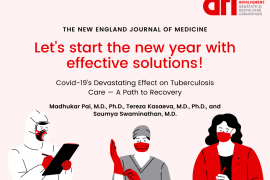News
"Covid-19’s Devastating Effect on Tuberculosis Care — A Path to Recovery"
The new article in the New England Journal of Medicine discusses the devastating effects of COVID-19 on Tuberculosis care. Madhukar Pai, M.D., Ph.D., Tereza Kasaeva, M.D., Ph.D., and Soumya Swaminathan, M.D. draw attention to the existing disparities and disproportionality existing between countries and different social groups “Whereas 76% of people in high-income countries have received at least one Covid-19 vaccine dose, as of the end of December 2021, the rate was only 8% in low-income countries”.[1] Considering these disparities in anti-covid vaccine administration between countries, the new variants of Covid-19, as omicron, are particularly emerging and touching countries with low vaccine coverage and high rates of poverty and tuberculosis.
The Covid-19 pandemic significantly affected the provision of health services and support, which caused the increase of tuberculosis mortality for the first time in a decade. Additionally, it influenced the effectiveness of treatment “15% reduction in the number of people treated for drug-resistant tuberculosis, a 21% decrease in people receiving preventive treatment for tuberculosis infection”.
At the level of policy and budget management, it has been detected a decrease (from $5.8 billion to $5.3 billion) in global tuberculosis spending between 2019 and 2020.
Due to the changing priorities, decrease attention to the tuberculosis cause during the past 2 years, increase transmission is expected. WHO modelling suggests that the pandemic’s effects on tuberculosis incidence and mortality in 2020 will be exacerbated in 2021 and beyond.
The path to recovery will require both immediate, short-term steps and longer-term actions
1) Ending the Covid-19 pandemic quickly is critical for rebuilding tuberculosis services and other essential health services.
2) Highlight the worsening tuberculosis epidemic
3) Improving case detection (digital technologies, prediction analytics, mapping hotspots etc.)
4) Every country has scaled up its molecular-testing capacity for Covid-19, and this capacity could be used for tuberculosis testing, in combination with validation of simpler, nonsputum samples
5) Establishing multisectoral collaborations involving personal, societal and health system interventions
6) Increasing investment in the development of new tuberculosis tools, taking advantage of the scientific advances that rapidly produced Covid-19 vaccines, diagnostics, and drugs.
[1] Madhukar Pai, M.D., Ph.D., Tereza Kasaeva, M.D., Ph.D., and Soumya Swaminathan, M.D. “Covid-19’s Devastating Effect on Tuberculosis Care— A Path to Recovery”, The New England Journal of Medicine, January 5, 2022. Covid-19’s Devastating Effect on Tuberculosis Care — A Path to Recovery | NEJM
Other news
- 18 July 2022Ensuring access for psychological, sexual reproductive health and HIV prevention services for Adolescent Girls and Young Women refugees with a focus on key and vulnerable populations (people living with HIV, children and adolescents, women etc)
- 19 June 2022Assessment of the level of training of sex workers in Chisinau (capital of the Republic of Moldova) in Community Mobilization, including involvement in HIV control measures
- 14 April 2022A pilot implementation study to scale-up methadone in incarcerated persons with opioid use disorder and retain them on treatment after release in Moldova

